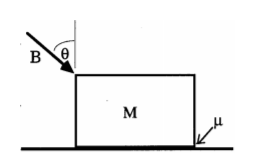An astronaut pushes a block and mass M that is on a surface as shown in Fig. 1(c). A magnitude of the force applied by the astronaut is B and the direction is given by angle θ in the figure. This experiment is done in space where gravity is negligible. The coefficients of static and kinetic friction between the block and the surface are both µ. (a) Assume that the block does not move. Draw the free-body diagram with all the forces acting on the block. (b) Consider that the block still does not move, find the magnitude of the forces acting acting on the block as a function of the given quantities. (c) Consider now that the astronaut wants the block to move. move. He will accomplish this by pushing harder (changing B), or pushing at a different angle (by changing θ), or by changing both? Find the requirement needed for B and/or θ for the block to start moving. motion. If there is no constraint on B and/or θ explain why.
An astronaut pushes a block and mass M that is on a surface as shown in Fig. 1(c). A magnitude of the force applied by the astronaut is B and the direction is given by angle θ in the figure. This experiment is done in space where gravity is negligible. The coefficients of static and kinetic friction between the block and the
surface are both µ. (a) Assume that the block does not move. Draw the free-body diagram with all the forces acting on the block. (b) Consider that the block still does not move, find the magnitude of the forces acting acting on the block as a function of the given quantities. (c) Consider now that the astronaut wants the block to move. move. He will accomplish this by pushing harder (changing B), or pushing at a different angle (by changing θ), or by changing both? Find the requirement needed for B and/or θ for the block to start moving. motion. If there is no constraint on B and/or θ explain why.

Step by step
Solved in 4 steps with 2 images









